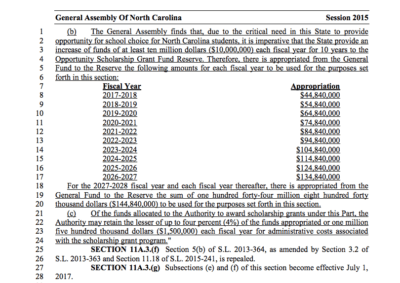
The approach of Super Bowl LI and a long essay in The New Yorker magazine — with the print-edition headline, “Can Football Be Saved?’’ — brought to mind again that searing image of Carolina Panthers linebacker Luke Kueckly sobbing and heaving as his body coped with an on-field concussion. Designated with that self-important Roman numeral, the Super Bowl signifies how deeply rooted football remains in the national culture — and that includes American high schools.
The National Federation of State High School Associations reports that 1.08 million students played organized school-based 11-man football in 2015-16. According to the federation’s state-by-state listing, North Carolina had 29,485 high school football players, down from 35,214 six years ago.
In 2015-16, 202,000 North Carolina teenagers took part in competitive athletics on school teams — 113,000 boys, 89,000 girls. Basketball, baseball, soccer, and track and field attracted tens of thousands of high school students.
The participation data make clear what a powerful force athletics is in the educational enterprise, in both state and nation. While most other nations run their teenage sports through community civil authorities, the U.S. is distinctive in having school-centered athletics.
In North Carolina, high schools join together for the governance of sports through an independent Chapel Hill-based association. Formed more than 100 years ago out of the University of North Carolina, the North Carolina High School Athletic Association Inc. ranks among the power centers of education in the state.
The NCHSAA collects dues from member schools. In addition, it has built up an endowment of nearly $18 million. The association aligns schools into divisions by enrollment and supervises game officials. It also has standards for football helmets, and regulates days and hours of football practice in pads for body-to-body contact.
In mid-2011, then-Governor Bev Perdue signed into law a concussion awareness act passed by the legislature. In turn, the State Board of Education assigned the NCHSAA with enforcing the law. It requires schools to have emergency plans for serious injuries and post-concussion protocols.
Earlier this week, I had an informative conversation with NCHSAA Commissioner Que Tucker. Here are short summaries of matters we discussed:
- The growth of charter schools has created an issue within the association. Charters mostly fall into the 1A classification of smaller schools. Yet, teams from charter schools, with students from affluent families who can afford the finest equipment, have begun winning championships by defeating schools in poorer rural communities. “Our 1A schools say the playing field is no longer level,’’ said Ms. Tucker, who added that the association is studying the issue.
- To try to offset inequality, Ms. Tucker said, the association spends the proceeds from its endowment to assist schools with large numbers of students who quality for free and reduced-price lunches. She pointed to a recent grant for modern lighting for the Plymouth football field. The endowment also offers college scholarships.
- I asked Ms. Tucker about my concern, expressed in an earlier EdNC column, about the length of the football and basketball seasons. In football, teams that make the playoffs end up playing 13, 14, or 15 games. The season runs from pre-season practice in August to championships after Thanksgiving – and there’s spring practice, too. Yes, she said, “we think we play too many games.” And yet, there is push-back against efforts to shorten the schedules. “Football helps pay the bills,’’ she said. Schools use the revenue to finance other sports, and the NCHSAA has a one-dollar surcharge on playoff tickets that goes into its endowment.
- Fewer games in football, and in other sports, would reduce the chances of injury. There is also the challenge of finding the right balance between athletics and academics. No doubt, participation in athletics, band, chorus, drama club, and other outside-class activities enrich the high school experience in terms of both education and community-building. Football undoubtedly keeps many young men in school and on track to graduate. Still, Ms. Tucker strikes the right note when she says that “we might need to do a new study’’ on the effects of school-based athletics.
In the interests of both student-athletes’ safety and educational advancement, the state needs an on-going, informed discussion over the scale of high school sports.
Recommended reading



